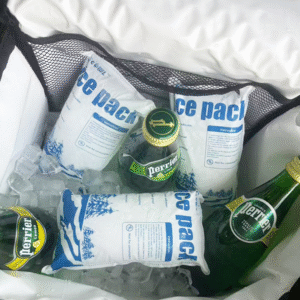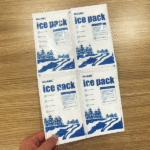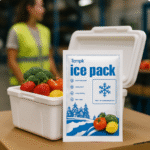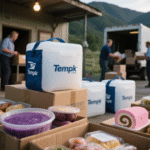How Much Dry Ice Do I Need for a 12x12x12 Shipping Bag?
Shipping perishable goods like seafood, pharmaceuticals, or frozen food requires precise temperature control to ensure products arrive safely. The right amount of dry ice is essential for maintaining the desired temperature. But how much dry ice is necessary for a 12x12x12 shipping bag? In this article, we’ll discuss how to calculate the right amount of dry ice based on several key factors such as shipping duration, external temperature, insulation quality, and more.
-
How do I calculate the amount of dry ice for a 12x12x12 shipping bag?
-
What factors influence the amount of dry ice needed?
-
How can I maximize the efficiency of dry ice in shipping?
-
What are the common mistakes when using dry ice for shipping?
-
How long does dry ice last in a 12x12x12 shipping bag?
How Do I Calculate the Amount of Dry Ice for a 12x12x12 Shipping Bag?
To determine the appropriate amount of dry ice, you need to consider multiple factors, such as shipping time, ambient temperature, and insulation quality. Typically, for every 24-hour period of shipping, you’ll need:
-
5-10 pounds of dry ice for 24 hours
-
10-20 pounds for 48 hours
-
20-30 pounds for 72 hours
Example:
If you’re shipping frozen seafood in a 12x12x12 box for 48 hours, you should plan for 10-20 pounds of dry ice to keep the items frozen throughout the journey.
Step-by-Step Calculation:
-
Measure the Volume: A 12x12x12 box holds 1,728 cubic inches or 30 quarts. This is important because dry ice sublimates based on the volume inside the container, not just the product weight.
-
Duration of Shipping: Calculate the duration in days and multiply by the sublimation rate:
-
5-10 pounds per 24 hours
-
Adjust for longer durations as needed.
-
-
Insulation Quality: High-quality insulation (e.g., vacuum panels) reduces sublimation, meaning less dry ice is needed. Poor insulation increases the sublimation rate, requiring more dry ice.
What Factors Influence the Amount of Dry Ice Needed?
1. Shipping Duration
The longer the shipping time, the more dry ice is required. For example, for a 3-day shipment, you will need more dry ice than for a 1-day shipment.
2. External Temperature
Warmer climates cause dry ice to sublimate faster. In hot weather, you’ll need more dry ice to counteract heat gain. Similarly, for cooler environments, less dry ice is needed.
3. Type of Product
Some products, like biological samples or frozen foods, require more cooling than others. Frozen meats, for instance, will need more dry ice than cosmetics.
4. Insulation Quality
The better the insulation in your shipping bag, the less dry ice you’ll need. High-quality insulated packaging slows down the sublimation process, helping preserve the dry ice for longer periods.
| Factor | Impact on Dry Ice | Best Practice |
|---|---|---|
| Shipping Duration | Longer = more dry ice | Increase dry ice for longer durations |
| External Temperature | Warmer = faster sublimation | Use more dry ice in hot weather |
| Type of Product | Sensitive items need more | Tailor dry ice to product sensitivity |
| Insulation Quality | Better insulation = less ice | Use high-quality insulated bags |
Example:
Shipping pharmaceuticals for 48 hours requires precise temperature control. For a 12x12x12 box, plan for 20 pounds of dry ice to keep the products within the required temperature range.
How Can I Maximize the Efficiency of Dry Ice in Shipping?
To extend the cooling duration and reduce dry ice consumption, follow these tips:
-
Pre-chill the Shipping Bag: Before packing, chill the bag to reduce dry ice usage.
-
Use Larger Dry Ice Blocks: Larger blocks sublimate more slowly, lasting longer than smaller pieces.
-
Proper Placement: Place dry ice at the bottom of the shipping bag to allow cold air to rise and evenly cool the contents.
-
Limit Opening: Opening the bag increases the rate of sublimation. Keep the bag sealed as much as possible during transit.
| Tip | Expected Outcome |
|---|---|
| Pre-chill the Shipping Bag | Reduces dry ice consumption |
| Use Larger Dry Ice Blocks | Extends cooling duration |
| Proper Placement | Maximizes cold distribution |
| Limit Opening | Preserves dry ice for longer |
Example:
A business shipping frozen desserts can extend the life of dry ice by using large blocks and pre-chilling the shipping bag.
What Are the Common Mistakes When Using Dry Ice for Shipping?
Several mistakes can reduce the efficiency of dry ice and potentially lead to product spoilage:
-
Underestimating Dry Ice Needs: Always plan for more dry ice than the minimum estimate to avoid undercooling.
-
Improper Packaging: Insufficient insulation can cause dry ice to sublimate too quickly. Always use high-quality packaging.
-
Sealing in Airtight Containers: Dry ice creates carbon dioxide gas during sublimation. Never seal it in airtight containers, as this can cause dangerous pressure buildup.
| Mistake | Impact | Solution |
|---|---|---|
| Underestimating Dry Ice Needs | Insufficient cooling | Always calculate extra dry ice |
| Improper Packaging | Faster sublimation | Use high-quality insulated bags |
| Sealing in Airtight Containers | Risk of explosion | Store dry ice in well-ventilated containers |
Example:
A business shipping medical supplies may mistakenly use too little dry ice, resulting in spoilage of the products. Always overestimate when in doubt.
How Long Does Dry Ice Last in a 12x12x12 Shipping Bag?
The duration that dry ice lasts depends on several factors:
-
5-10 pounds of dry ice will last about 24 hours.
-
10-20 pounds lasts 48 hours.
-
20-30 pounds can last 72 hours or more, depending on conditions.
Remember, higher external temperatures accelerate sublimation. Always adjust the dry ice amount based on weather conditions.
2025 Trends in Cold Chain Logistics and Dry Ice Shipping
The cold chain logistics industry is evolving rapidly. Here are key trends shaping dry ice usage in 2025:
-
Smart Monitoring: Real-time temperature tracking systems allow businesses to monitor dry ice usage and optimize efficiency.
-
Sustainable Practices: Eco-friendly alternatives, such as phase-change materials (PCMs), are being adopted to reduce the environmental impact of dry ice.
-
Advanced Insulation: Innovations in insulation materials are improving the lifespan and efficiency of dry ice.
Latest Developments
-
Smart Sensors: IoT-enabled sensors provide real-time data on temperature and location, reducing risks of damage.
-
AI for Route Optimization: Artificial Intelligence (AI) is helping companies choose the most efficient shipping routes based on real-time data.
-
Sustainable Packaging: Companies are adopting recyclable and reusable packaging to reduce their carbon footprint.
FAQ
Q1: How much dry ice do I need for a 12x12x12 shipping bag for 24 hours?
For a 12x12x12 shipping bag, 5-10 pounds of dry ice is typically sufficient for a 24-hour shipment.
Q2: Can I store dry ice in a regular cooler?
No, dry ice must never be stored in an airtight cooler. Always use a cooler with proper ventilation to avoid dangerous pressure buildup.
Q3: How long does dry ice last in a 12x12x12 shipping box?
In a well-insulated box, 5-10 pounds of dry ice will last for 24 hours, and 10-20 pounds for 48 hours.
Conclusion and Recommendations
To ensure your temperature-sensitive items arrive safely, calculate the correct amount of dry ice based on shipping time, ambient temperature, insulation quality, and product sensitivity. Following best practices like pre-chilling, using larger blocks of dry ice, and optimizing packaging can help extend the dry ice’s cooling power.
Next Steps:
-
Calculate the required dry ice based on your specific shipping needs.
-
Use high-quality insulation to optimize dry ice efficiency.
-
Store dry ice properly to avoid safety hazards and extend its cooling duration.
About Tempk
Tempk provides top-tier cold chain solutions, specializing in dry ice, gel packs, and insulated packaging. We deliver reliable temperature control products for businesses, ensuring the safe transit of perishable goods. Our expertise helps optimize your cold chain logistics strategy.
























